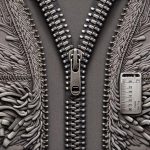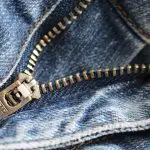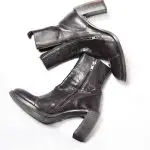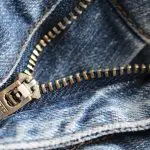Have you ever wondered how many teeth your pants zipper has? You may not give it much thought, but zippers are an essential part of our daily lives. From clothing to bags, zippers are everywhere.
But, have you ever considered the intricate details that make up a zipper? The number of teeth a zipper has is an important aspect of its functionality. The more teeth a zipper has, the stronger and sturdier it is. However, the number of teeth can vary depending on the type of zipper and its intended use.
In this article, we will explore the anatomy of a zipper and delve into the factors that affect the number of teeth in a pants zipper.
Table of Contents
Types of Zippers
Let’s explore the different types of zippers, shall we? Zippers come in various designs and materials, but the two most common types are coil and tooth zippers.
Coil zippers are made up of nylon or polyester coils that are sewn onto the fabric. These zippers are flexible, lightweight, and easy to sew, making them ideal for use in clothing, bags, and outdoor gear.
Tooth zippers, on the other hand, are made up of individual metal or plastic teeth that interlock to form a chain. These zippers are stronger and more durable compared to coil zippers, and are often used in heavy-duty applications like jackets, tents, and luggage. Tooth zippers also come in different sizes, with the number of teeth per inch determining the size.
Another type of zipper is the invisible zipper, which is designed to be hidden in the seam of a garment. Invisible zippers are commonly used in formal wear like dresses and skirts. They have smaller teeth and a narrow tape, which makes them less noticeable when sewn into the garment.
Understanding the different types of zippers is important when choosing the right one for your project. Coil zippers are best for lightweight and flexible applications, while tooth zippers are great for heavy-duty use. Invisible zippers are perfect for formal wear, where a seamless finish is desired.
So, next time you’re shopping for zippers, consider the type that best suits your needs.
Anatomy of a Zipper
The intricate design of a zipper consists of a series of interlocking metal coils that are attached to a fabric tape, allowing the zipper to open and close. The top of the zipper is called the ‘slider,’ which is the part that you pull up and down to open and close the zipper.
The teeth of a zipper are the small metal or plastic pieces that interlock with each other, keeping the zipper closed and secure. The teeth come in a variety of shapes and sizes depending on the type of zipper. For example, some zippers have teeth that are shaped like diamonds, while others have teeth that are shaped like rectangles.
The bottom of the zipper is called the ‘stopper,’ which is the part that prevents the slider from coming off the end of the zipper. The stopper is typically made of metal or plastic and is attached to the end of the zipper tape.
Now that you know the anatomy of a zipper, you can appreciate the intricate design that goes into making this everyday item.
How Teeth are Counted
You might not realize it, but every zipper you own has a specific number of teeth carefully counted and placed to ensure a smooth and secure closure. Have you ever wondered how these teeth are counted? Well, let’s dive into it!
Firstly, it’s important to note that the number of teeth on a zipper can vary depending on the size and intended use of the zipper. A standard zipper on a pair of pants might have around 10-15 teeth, while a heavy-duty zipper on a backpack could have upwards of 50 teeth.
To count the teeth on a zipper, manufacturers use a special tool called a ‘zipper gauge.’ This tool has a series of teeth-shaped notches that match up with the teeth on the zipper. The manufacturer simply lines up the notches with the teeth and counts how many notches there are, giving them the total number of teeth on the zipper.
So there you have it, the number of teeth on a zipper is crucial to its function and is carefully counted and placed during the manufacturing process. Next time you use a zipper, take a moment to appreciate the thought and precision that goes into creating such a small but important component of our everyday lives.
Factors Affecting Teeth Count
When it comes to teeth count, there are a few factors that can influence the number of teeth on a zipper. The length of the zipper is one of the most important factors, as longer zippers tend to have more teeth.
The type of zipper and the manufacturing process used can also impact the number of teeth on a zipper.
Length of Zipper
As you measure the length of a zipper, you can also determine the number of teeth it has. Zippers are measured from the top stop to the bottom stop, which are the metal or plastic pieces at the top and bottom of the zipper that prevent the slider from coming off. The length of the zipper affects the number of teeth it has, as longer zippers typically have more teeth than shorter ones.
To give you an idea of how the length of a zipper affects its number of teeth, here’s a table that shows the approximate number of teeth for different lengths of zippers:
| Zipper Length | Number of Teeth |
|---|---|
| 4 inches | 17 teeth |
| 8 inches | 34 teeth |
| 16 inches | 68 teeth |
As you can see, the longer the zipper, the more teeth it has. This is because the teeth need to be closer together to ensure that the zipper stays closed when it is zipped up. So the next time you’re wondering how many teeth a zipper has, just measure its length!
Type of Zipper
Take a look at the different types of zippers available, from invisible zippers to separating zippers, to choose the perfect one for your project. The type of zipper you choose will depend on the function and design of your garment or accessory.
Invisible zippers are perfect for formal dresses and skirts, while separating zippers are ideal for jackets and sportswear.
Coil zippers are the most common type of zipper and are widely used in clothing and accessories. They’re made of nylon or polyester coils that are sewn onto a fabric tape. Coil zippers are flexible and easy to sew, making them a popular choice for beginners.
On the other hand, metal zippers are more durable and are often used in jeans and heavy-duty jackets. They have metal teeth that interlock and are stronger than coil zippers.
When choosing a zipper, consider the weight of the fabric, the type of garment or accessory, and the desired look and functionality.
Manufacturing Process
Now that you have learned about the different types of zippers, let’s dive into the manufacturing process. The process of making a zipper involves multiple steps, including die-casting, electroplating, and assembly. In this section, we will take a closer look at each step and understand how they contribute to the final product.
The manufacturing process of zippers begins with die-casting, where molten metal is poured into molds to create teeth. Once the teeth are formed, they are sent for electroplating, where a thin layer of metal is applied to the surface to increase their durability. The teeth are then sorted and matched with the tape, which is the fabric that holds the teeth together. Finally, the teeth and tape are assembled using high-speed machines to create the final product. To give you a better idea of the manufacturing process, take a look at the table below which outlines the steps involved in making a zipper.
| Step | Description |
|---|---|
| Die-casting | Molten metal is poured into molds to create teeth. |
| Electroplating | A thin layer of metal is applied to the surface of the teeth. |
| Sorting | Teeth are sorted by size and matched with the tape. |
| Assembly | Teeth and tape are assembled using high-speed machines. |
| Quality Control | Zippers are inspected for defects and imperfections. |
Understanding the manufacturing process of zippers can help you appreciate the effort that goes into creating high-quality zippers. From the die-casting of the teeth to the assembly of the final product, each step is essential in creating a functional and durable zipper. Next, we will explore the fascinating question of how many teeth pants zippers have.
Importance of Teeth Count
You’re probably wondering why the number of teeth on a pants zipper is important. Well, the answer lies in the functionality of the zipper.
The number of teeth determines how smooth the zipper moves and how strong it is. A zipper with more teeth will be smoother and stronger than one with fewer teeth.
The importance of teeth count becomes especially relevant when you’re buying pants with zippers. If you’re someone who wears pants with zippers frequently, it’s important to consider the number of teeth on the zipper.
If the zipper has too few teeth, it might not be strong enough to hold the pants together. On the other hand, if it has too many teeth, it might not move smoothly, making it difficult to zip and unzip the pants.
So, the next time you’re shopping for pants with zippers, make sure to check the number of teeth on the zipper. It’s a small detail that can make a big difference in the functionality of the zipper and the overall comfort of the pants.
A smooth and strong zipper will make your life easier and more comfortable, so don’t overlook this important aspect of pants with zippers.
Other Interesting Zipper Facts
If you’re a fashion enthusiast, zip it up and get ready to learn some fascinating zipper trivia. Here are three interesting zipper facts you might not know:
-
The first patent for a zipper was issued in 1851, but it took almost 40 years for the modern zipper we know today to be developed. The first zippers were clunky and unreliable, but improvements in technology allowed for the creation of smoother and more efficient zippers.
-
Zippers can be found in a wide variety of products, from clothing to luggage to sporting equipment. They can also be made from a variety of materials, including metal, plastic, and even fabric.
-
The world’s longest zipper measures over 3 miles long and was used on a giant inflatable slide in Los Angeles.
While this zipper is certainly impressive, it’s important to remember that most zippers are much smaller and used for more practical purposes.
- Are Tweed Suits Worth It? - April 24, 2024
- Is Tweed More Expensive Than Wool? - April 24, 2024
- Is Tweed Fabric Itchy? - April 24, 2024







